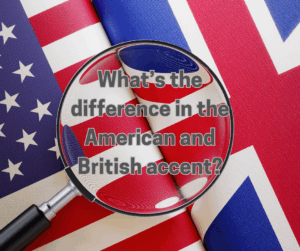Key Differences and Tips for Accent Reduction
Want to know the key differences between American and British pronunciation? Understanding these pronunciation differences is important if you’re working on accent reduction or just want to speak English more clearly. Whether you’re getting ready for work presentations or just want to sound more confident, learning these accent patterns will really help your speaking skills.
What Makes These Accents Different?
American and British accents sound different because they developed separately over hundreds of years. Even though they use the same grammar rules, the way people pronounce words, especially vowels, creates totally different sounds.
American English (what most Americans speak) is “rhotic” – which just means you hear the R sounds clearly in all word positions. British English, especially the fancy “Received Pronunciation” style, often drops R sounds in the middle or end of words and has more variety in vowel sounds.
Vowel Sounds: Where the Magic Happens
The “A” Sound Changes
This is probably the biggest difference you’ll notice between American and British speakers:
How Americans Say It:
“A” is pronounced with jaw dropped and tongue tip by bottom front teeth
-
- “Bath” sounds like “baath” (flat A sound)
-
- “Dance” comes out as “daance”
-
- “Fast” sounds like “faast”
How British Speakers Say It:
“A” is pronounced with the mouth open and lips and jaw relaxed. It sounds more like a “o”
-
- “Bath” sounds like “baahth” (broader A sound)
-
- “Dance” becomes “dahnce”
-
- “Fast” sounds like “faahst”
The “O” Sound Differences
The letter “O” also shows big differences:
American Style:
“O” is pronounced with the mouth open and lips and jaw relaxed
-
- “Hot” and “lot”
-
- “Coffee”
British Style:
“O” is pronounced with round lips and pull back tongue while keeping tongue tip low, like in the word, “coat”
-
- “Hot” and “lot”
-
- “Coffee”
How Consonants Work Differently
The R-Sound Rule
American Accent:
You hear R sounds everywhere in the word
-
- “Car”
-
- “Better”
-
- “Farm”
-
- “Sorry”
British Accent:
R sounds often disappear at word endings and at then end of syllable
-
- “Car” sounds like “cah”
-
- “Better” becomes “bettah”
-
- “Farm” becomes “fahm”
-
- “Sorry” become “sah ry”
The T-Sound Trick
American English:
T sounds get softer in the middle of words, almost like D sounds
-
- “Water” sounds like “wader”
-
- “Better” comes out as “bedder”
British English:
T sounds stay crisp and clear
-
- “Water” keeps its sharp T sound
-
- “Better” maintains distinct T sounds
Words That Really Show the Difference
Here are some everyday words that sound totally different:
Schedule: Americans say “SKE- dwule” but British speakers say “SHE- dule”
Privacy: Americans put stress on the first part “PRY-vu-cy” but British stress the middle “pri-VU-cy”
Advertisement: Americans say “ad-ver-TIZE-ment” versus British “ad-VERT-is-ment”
Speech Rhythm and Flow
American English Flow
American English has a more relaxed, smooth flow. People stress the important words, move smoothly between syllables, and keep a pretty steady pitch.
British English Flow
British English tends to be more precise. Each syllable gets clear pronunciation, speech patterns are more clipped and efficient, and there’s more variety in pitch within sentences.
Tips to Improve Your Accent
Want to Sound More American?
Practice saying R sounds clearly in all parts of words. Work on making A sounds flatter in words like “dance” and “bath.” Focus on relaxed vowel sounds and develop a smooth, flowing way of speaking.
Want to Sound More British?
Practice dropping R sounds at the ends of words and syllables. Work on making A sounds more like “o” in “cot”. Keep your consonants crisp and clear, and focus on precise pronunciation.
Getting Professional Help
Learning to change your accent works best with some guidance. You might want to try online accent courses that teach pronunciation step by step, work with speech therapists who specialize in accents, use pronunciation apps that let you practice American or British sounds, or join conversation groups focused on accent practice.
For professional accent training, book an appointment with me for a free consultation.
Using Technology to Practice
Today’s tech makes accent practice much easier. You can use voice recording apps to hear yourself and track progress, try pronunciation software that gives you instant feedback, use online dictionaries with audio examples, and practice with native speakers through video calls. You can also use Forvo.com to hear how words should sound and try a sound pronunciation for detailed practice.
Tracking Your Progress
Getting better at accent work takes regular practice and checking how you’re doing. Record yourself regularly to hear improvements, ask native speakers for feedback, and notice how confident you feel during conversations. Professional accent coaches can give you detailed reviews and personalized tips for getting better.
Wrapping Up
Learning the differences between American and British accents takes practice and understanding specific sound patterns. Whether you pick American or British accent training, focus on being consistent, clear, and confident when you speak. With good help and regular practice, you can reach your accent goals and become a better communicator.


Very interesting info!Perfect just what I was looking for!
Thank you, let me know if I can share any more information on another or similar topic.